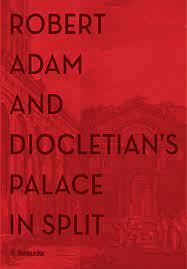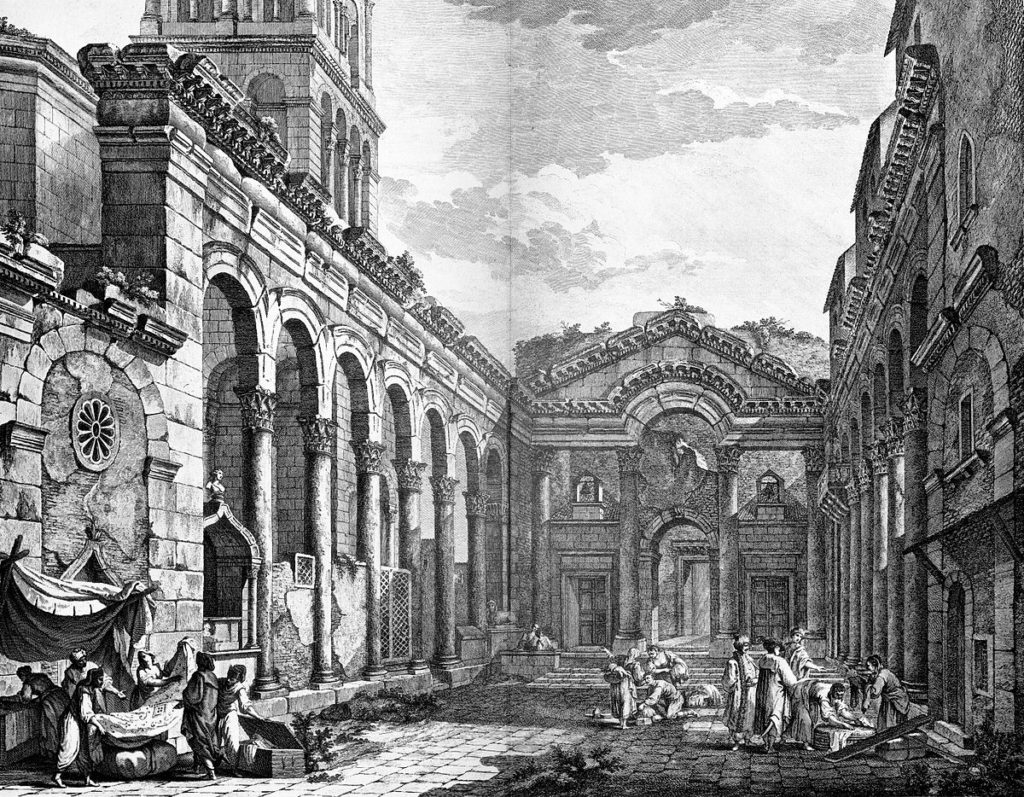This post is also available in: Croatian

For centuries, the beautiful Mediterranean city of Split, located between the Marjan Hill and the Adriatic Sea, has attracted visitors from all over the world. Here they discover monuments from times long-gone, touch the thumb of Grgur Ninski and explore cellars of Diocletian’s Palace, marveling at this magnificent architectural monument.

They also enjoy Marjan, “the lungs of the city,” creating beautiful moments for their treasure boxes of memories. However, the story of this glorious city can be told in a completely different way: through the history of the Jewish community in Split with explorers, artists and mayors that will soon find their place in new specialized storytelling tours.

The Story of Robert Adam Discovering His Own Style
Diocletian’s Palace in Split has always attracted international travelers, writers, historians, architects, and archaeologists curious about one of the best-preserved antique monuments in the world. Many of them tried to describe it but only the rare British architect of Scottish origin managed to do so, Robert Adam, who was mesmerized by Roman architecture and began to explore antique architectural structures. As he was intrigued by Emperor Diocletian and “the Emperor’s monumental villa” in Split, he decided to visit this monumental city and learn more about the private architecture of ancient Romans. His first glimpse of the town was from the sea: “The moment you sail in between the two capes extending into the sea that form a large bay and a friendly harbor, you will see the remains of the walls facing the sea and a long arcade of the Emperor’s Palace, a modern fortress, a lazaretto and towers located within the walls as well as one of the ancient temples. The urban structures are perfectly harmonized with the surrounding hills creating beautiful scenery. Upon his return to London, Adam spent 6 years preparing etchings for 61 etching plates. He published the book Ruins of the Palace of Emperor Diocletian at Spalato in Dalmatia in 1764.

Adam’s visit to Split and the Diocletian’s Palace influenced his work and in part inspired his own style of interior decoration, named “Adam’s style.” He was deeply influenced by ancient civilizations. His experience of the Split’s architectural masterpiece, especially the southern façade of the Diocletian’s Palace, is visible on the Register House in Edinburgh and in the orangery of the Bowood House in Wiltshire, known as the Diocletian Wing. Simultaneously, the Adelphi Buildings on the Thames in London represent his interpretation of the whole Diocletian Palace.
Robert Adam was so astonished by Peristyle, a half capital from Diocletian’s Palace that he used it to decorate the façade of a building located on St James’ Square in London. His architectural style was so strongly influenced by Split’s ancient monuments that he included the sketch of the entire capital in his book The Works in Architecture of Robert and James Adam.
Jewish Heritage in Split

Jews in Split is the name of a storytelling tour that will take you all the way back to ancient times. Jews have been living in Split ever since the times of Emperor Diocletian, and stonecutters’ symbols on the walls of the Palace testify to their presence in the Palace. A Jewish cemetery and decorated menorahs, Jewish candleholders from the 3rd century tell us a story about their lives in Salona (today’s Solin).

Although persecution has been the major part of the history of Jewish people, they were welcomed in Split thanks to their excellent multilingual and trade skills. Daniel Rodrigues, a Jewish community member in Split anda tradesman,left the most significant trace.In honor of his contribution to the evolution of the city of Split, a street was named after him – Rodrigina Street that was once inhabited by Jews exclusively. Next to it, in Židovski prolaz (Jewish passage), one of the oldest still active synagogues in Europe and the only one in Split found its home. It was built in the 16th century. Well-preserved, it tells a story of the influence of the community up to the 18th century.

Today, the Jewish community of Split has approximately a hundred members that occasionally organize exhibitions and lectures. Work hours are from 10 a.m. to 2 p.m., on work days.

The Mayors of Split
A storytelling tour named The Mayors of Split tells a story of visionaries that have shaped Split as it is today. The guided tour starts on Prokurative with a tale of Antonio Bajamonti, a medical doctor and an adored mayor of Split for almost twenty years. He turned a neglected and poor varošica (a small town) into a modern Mediterranean city. He renovated the Roman aqueduct, introduced gas mantles, and built the Bajamonti Theatre.
The tour continues on Splitska Riva, where the scent of sulfur can be felt due to the sewage collectors constructed thanks to the mayor Grabić.
While strolling down the Riva, the scent of sulfur reminds us of “sulfur spas,” and “furešti” (a slang expression for foreigners) who should learn about the mayor Grabić, thanks to whom today’s Riva smells only of sulfur.
Today’s King Zvonimir Street was once known as Dr. Ivo Tartaglie Street, named after the favorite mayor of citizens of Split, a lawyer, politician, and painter. Thanks to his efforts, electricity supply was introduced in Split as well as it was connected to the mainland through Lički railway constructed in 1925. You will get a chance to find out more about this street that you will reach from the Riva.
This storytelling tour ends near Koteks, the first shopping center in ONE communist country. There, the participants will get a chance to find out more about the mayors of Split during the most significant city’s industrial-construction expansion and about the famous Mediterranean Games.

World War Two in Split
This is a story about the citizens of Split and their struggles during the Second World War. A war means destruction, pain, and suffering, and Split was no exception during the Second World War. The terrific bombardment of Split destroyed almost 20% of homes. However, innocent victims (citizens of the town) are those who suffered the most extensive injustice.

Tyranny was a form of rule of the new government that imposed new restrictions on living. Every new day brought further instability, sometimes in the form of price inflation, sometimes in the form of scarcity (of all essential goods) and sometimes in the form of the bloodcurdling howling of air raid sirens or random street checks or cardings and arrests.
Participants in this storytelling tour will learn about the atmosphere in Split during those dark times with an emphasis on the local population. In addition, they will hear about the postwar period, influences of which are still present but overshadowed by the war.

A Story about Split’s Mentality “The Craziest Town in the World”
We always wonder what makes this city, in which everything is acceptable, so special. The answer is that this is the craziest city in the world, with no further explanations needed.
States are changing, governments come and go, but the citizens of Split remain the same – unpredictable, passionate, loud, wild… Their mentality has become a brand. Splićani (citizens of Split) take pride in it as something more resilient than systems and ideologies. The small and the big town, as described by Uvodić, Smoje, or Kudrjavcev, each of them from their own perspective and their own interests provide the best insight into the “craziness of Split.” The characteristics are mainly negative – defiance, mockery, gossiping, hedonism… However, in this town, some reversed rules are in power. So everything that can be experienced as something negative at first, with time, becomes something adorable, and holding grudges does not exist.
No other city can take pride in eccentric characters born in Split, so-called ridicules, that transformed Split into u perfect stage for Fellini movies. Only in Split are people “fjakani” (meaning tired and melancholic). Small talks and gossip are the top priority of daily coffees. Yes, when drinking coffees in Split’s cafes, we all talk about “grandece” (the grandeur of people). We pretend that we possess more than we really do; vanity is our virtue, and spitefulness would make us climb Mount Everest.

We sincerely believe that you will join at least one of our special storytelling tours and discover Split from a different perspective – by learning about people that breathed and lived in this city and have contributed immensely to its culture and tradition.
DALMATIA – STORYTELLING DESTINATION
Revival of storytelling in museums and institutions to preserve cultural heritage is a unique project in Croatia and Europe. In Dalmatia, as a storytelling destination, 14 characters of the area’s rich heritage have been revived. In addition to this project, 23 themed tours have been created. This project, intended for tourists and the local population, is focused on providing authentic experiences of cultural heritage through storytelling. These commercial guided tours will be available through the County’s storytelling platform that offers storytelling tours led by knowledgeable and certified guides wearing costumes. The project aims to preserve and publicize Dalmatian cultural heritage and create attractive 365 tourist offers in Splitsko–Dalmatinska County.
Knowledgeable and certified guides are:
The Story of Robert Adam Discovering His Own Style in Split: Maja Bilić
Jewish Heritage in Split: Lea Altarac
The Mayors of Split: Maja Benzon
The World War Two in Split: Ina Nikolić
A Story about Split’s Mentality “The Craziest Town in the World”: Luisa Quien
Photo credits: Dalmatia – Storytelling Destination; photo archive of TV series Malo misto; archives of certified storytelling guides; Wikipedia
This post is also available in: Croatian
